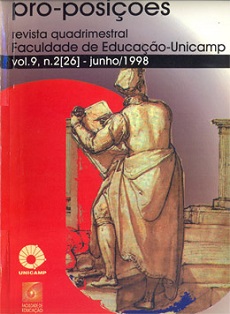Resumo
Neste artigo a autora discute a dimensão estética do currículo, tomando a dan- ça como centro de seu argumento a favor de um ensino que se preocupe com a moral, com a visão crítica do mundo e com a possibilidade dos alunos e alunas conectarem suas experiências à consciência daquilo que significa ser humano neste mundo, da maneira com que podemos viver juntos. A autora discute as principais correntes tanto da estética da dança ocidental no século XX quanto suas implicações e relações com o ensino de dança nas escolas, enfatizando, através de experiência pessoal, as possibilidades de uma educação em dança que ultrapasse as quatro paredes da sala de aula
Abstract:
In this article the author discusses the aesthetic dimension of curriculum taking dance education as central to her argument in favor of an educational process concerned with moral, a critica I view of the world and the possibility of students to connect their experiences to the significant questions of what is to be human in this world? How shall we live together? The author discusses the main aesthetic proposals in Western 20.h century dance and its implications and relationships with the teaching of dance in schools. Through personal experience, the author emphasizes the possibility of an education in dance that goes beyond the studio walls.
Descriptors: Aesthetics. Morality. Dance. Education. Curriculum
Referências
Beardsley,M. C. (1958). Aesthetics: Problems in the philosophy of criticism. Nova York: Harcourt, Brace and World.
Buber, M. (1955). Between man anel mall. Tradução de M. Friedman. Nova York:Harper.
Buber, M. (1958). 1 and Tholt. Tradução de R. G. Smith. 2a. ed. Nova York: Charles Scribner.
Czikszentmihalyi, M. (1975).Beyond boredom and anxie(y. São Francisco:Jossey-Bass.
Dewey,J. (1934). Art as ~perience. Nova York: Minton Balch.
Eisner, E.W (1979). 1beeducational il11a/{inatiorz.Nova York:Macmillan.
Gilligan, C. (1982).ltl a d(flerent voice: Psychological fheOlY and lvomen S deuelopment. Cambridge: Harvard University Press.
Greene, M. (1978). Landscapes qlleamillg Nova York:Teachers College Press.
Hawkins, E. (1969). The body is a dear place. In: M. Gray (org.). Foclts on Dance v.- Composifion. Washington, DC: American Association for Health, Physical Education and Recreation, pp. 34-39.
Kupfer, J. (1978). Aesthetic experience and moral education,journal ql Aesthetic Education 12, pp. 13-22.
Macdonald, J. B. (1977). Value bases and issues for curriculum. In: A. Milnar e J. Zahorek (orgs.). Cuniculum fheory. Monografia, pp. 10-2l.
Mc donald, J. B. (1978). A transcendental developmental ideology of education. In: J.R. Gress and D.E. Purpel (orgs.). Curriculu111. Berkeley: McCutchan, pp. 95-123.
Macdonald, J. B. e Purpel, D.E. (1983). Curriculum planning: Visions and metaphors.
:Z. Lamm (org.). New frends in educafion. Tel-Aviv:Yachdar United Publishers.
Marcuse,H. (1978).1be aesfhetic dil11e1zsiOII:Towanl a critique qlMa/xist aesfhetics. 8051on: Beacon Press.
Newman, A. J. (1980). Aesthetic sensitizing and moral education,journal ofAesthetic Education 14, pp. 93-1Ol.
Redfem, B. (1983).Dance. a/1 anel aesthetics. Londres: Dance Books Ltd.
Ross, M. (1981). Vou are the music. In: M. Ross (org.). Releva/Ice and re~pollsihility in a/ts education. Oxford: Pergamon.
A Proposições utiliza a licença do Creative Commons (CC), preservando assim, a integridade dos artigos em ambiente de acesso aberto.

